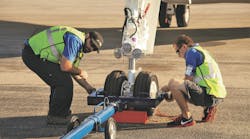INSIDE THE FENCE
By John Infanger, Editorial Director
June 1999
The numbers don't lie. There's truth in numbers. Insert your own axiom here.
If nothing else, the numbers we've collected from our own recent surveys and from various industry sources for this issue present a glimpse of the state of the airport business industry. There's a bit of commentary along the way as well.
Questions, comments, additional insights, and even more numbers are welcome. Meanwhile, moving along down the road of editorial observations ...
* * *
We're driving the Wisconsin countryside, every few miles another lake invites us, the Chicago news provides the background in the pickup.
"Computers at Midwest air traffic control are down. Expect delays at O'Hare and Midway," the newsman's voice calls out. It's followed by the obligatory newsradio ’live' report with delayed/stranded travelers. You can relate, of course, because just two weeks ago you were one of them.
Alas, the hotels around Chicago's commercial airports are doing an air traffic bangup of a business. You wonder: Has anyone studied the economic impact of ATC delays on hotels, night diners, 7-11s, etc.? Do airport hotels include this type of stuff in their original business plans? Is our industry one from which our delays mean profit and motive for the business of others?
If so, get online tonight and check out investment opportunities.
Today's history says that the microwave landing system was the rave of the early 1980s. However, as high-tech matters go, the technology rapidly moved past the installers, to the point that cancelling the program was the only way to save any money.
The process that is the U.S. ATC system is just that — a process. It is one that by its nature is slow to react and encumbered by the process of multilevel approval. In a technological world, the process loses the race.
Looking at the state of today's industry, so much is good — but too much is tentative. It's future relies on a system that may or may not keep pace.
Do re-wratcheting and re-programming what's already in place constitute the most prudent approach? It seems to be the only one the industry itself has the stomach for.
The most serious issue facing us today — and one which must be met short of tomorrow — is moving the system. Next comes having adequate facilities. At least, that's what educated people waving the caution flags are shouting.
It will be a shame if we build the adequate concrete, only to have it serve as a nationwide holding area where air carrier captains await instructions from a stalled system.
The answer lies within. Should the system lock up, some say, it will be the airlines dictating the airspace out of market necessity. And, it will be the voters (customers) who dictate the change using Congress as their instrument of choice. When that comes, we will have a new day borne out of inconvenience and political survival.
* * *
One for the road ...
If, by some miracle, we get this massive 5-year influx of aviation funding, remember that it goes to or through FAA. This is the same agency that is currently undergoing an investigation of its cost accounting process. Oh, and there are billions of dollars in question. Am I the only person that sees any irony in this? Are you nervous, too?
Thanks for reading.





